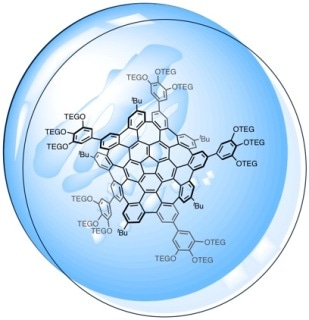Feb 20 2018
For the first time, a group of biologists and chemists at Boston College and Nagoya University has successfully synthesized a water-soluble "warped nanographene” molecule that shows immense promise for fluorescent cell imaging. The new molecule is flexible, biocompatible, and when exposed to blue laser light, also induces cell death.
The nanographene molecule, which was recently illustrated in the Angewandte Chemie International Edition journal, extends the biological applications for nanocarbons, such as cancer cell imaging and perhaps eradication.
 A new water-soluble warped nanographene. Hydrophilic chains on the periphery impart high water solubility. (Image credit: ITbM)
A new water-soluble warped nanographene. Hydrophilic chains on the periphery impart high water solubility. (Image credit: ITbM)
Nanographenes, which are nano-sized carbon molecules, have remarkable optical, mechanical, and electronic properties. They have been recognized as potential materials for both biomedical and electronic purposes. Yet, nanographenes have a flat structure that results in stacking and aggregation in solvents which make it hard to dissolve them in numerous solvents and thus lead to complications for biological applications.
Earlier in 2013, a warped nanographene molecule with a saddle-shaped structure was synthesized by Professor Kenichiro Itami, director of the JST-ERATO Itami Molecular Nanocarbon Project and the Institute of Transformative Bio-Molecules (ITbM) at Nagoya University and his colleagues. Aggregation is prevented by the distinctive organization of the molecule's 26 graphene rings, making the molecule soluble in most standard organic solvents. When irradiated with blue or ultraviolet light, the molecule also exhibits green fluorescence.
"We were really excited when we succeeded in synthesizing the warped nanographene molecule, and we were interested in making it available for biological applications, which we achieved by adding water-soluble functional groups to the molecule," says Itami.
In the new study, Itami's team explains how they came up with a simple method to render warped nanographenes water soluble. The researchers first substituted five hydrogen atoms with boron moieties, via an iridium-catalyzed C-H borylation reaction, and then mixed the boron-substituted warped nanographene with a compound, known as an aryl halide that contains water-soluble chains. A Suzuki-Miyaura coupling reaction, catalyzed by palladium, leads to the water-soluble chains coupling to the edges of the nanographene molecule, allowing it to be dissolved in organic solvents, including water. With the help of this technique, other functional groups can also be installed to warped nanographene to easily adjust its properties.
On examining the fluorescent characteristics of water-soluble warped nanographene, the researchers discovered that when the molecule is dissolved in water under ultraviolet light, it fluoresced yellow and when it is mixed in the standard organic solvent dichloromethane, it fluoresced green. The new nanographene molecule exhibited high photostability, which means that its properties do not change on exposure to light. Instead, the color of the fluorescence changes by the polarity of the solvents that they are mixed in.
Itami's team subsequently teamed up with ITbM's biologists to analyze whether the nanographene molecule is capable of staining live cells for fluorescent cell imaging. To find out this, the researchers used a water-soluble warped nanographene solution to treat HeLa cells – a strain of cervical cancer cells that is extensively used for research purposes. Microscopic observations revealed that the HeLa cells took up the molecule over a period of several hours and ultimately accumulated in the lysosomes – organelles found in cells. It was observed that cell viability did not change considerably over time, indicating that water-soluble warped nanographene molecule possess low cytotoxicity and could possibly be utilized as a fluorescent stain for HeLa cells.
However, under specific circumstances, the molecule can turn toxic. When irradiated with a blue laser, the treated HeLa cells displayed cell death after 30 minutes. On the other hand, untreated HeLa cells did not exhibit any cell death.
"Although our new warped nanographene has low toxicity to HeLa cells, we were surprised to find that cell death was observed upon irradiating light to the cells stained with the new nanographene," says Itami.
While the specific mechanism behind this cell death is not clear, the team believes that a deadly singlet oxygen molecule is produced during irradiation and this is what causes cell death. Although a number of other compounds are known to promote photo-induced cell death, molecules that are capable of absorbing longer wavelengths still need to be discovered so that they can be safely used for treating cancer cells in deep tissues.
The scientists envisage that their technique to functionalize and modify warped nanographene molecules could pave the way for biocompatible molecules that can absorb varying wavelengths of irradiation.
"We have succeeded in synthesizing a water-soluble warped nanographene showing fluorescence, good photostability and low cytotoxicity, which makes it promising for bioimaging," says Itami. "This achievement is an excellent example showing the output of the extensive collaboration between chemistry and biology ongoing at our institute. We hope that our molecules can be developed further for a wide range of biological applications through further interdisciplinary collaborations."
While more study is needed to determine the variability of nanocarbons, the result of this study does show that nanocarbons could possibly be used for a wide range of biological applications. It also demonstrates the rewarding synergy between biology and synthetic chemistry.